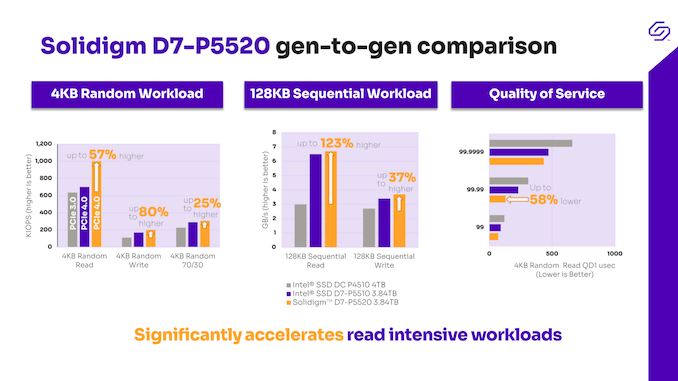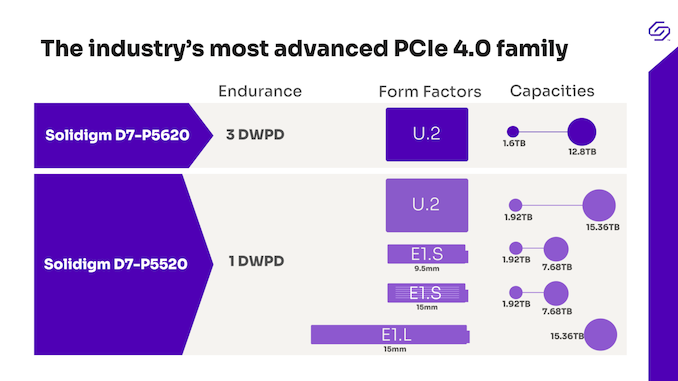Solidigm Launches First Post-Intel Enterprise SSDs: D7-P5620 and D7-P5520
by Ryan Smith on April 26, 2022 12:00 PM EST
Back in late 2021, Intel and SK hynix completed the first stage of their long-awaited transfer of Intel’s NAND (and NAND-based SSD) business to SK hynix. That company, in turn, took Intel’s NAND SSD assets and put them under their own subsidiary, Solidigm, who took over sales of Intel’s existing SSD portfolio. Now, a few months later, Solidigm is gearing up to release its first post-Intel SSDs, the enterprise-focused D7-P5520 and D7-P5620.
Diving right into matters, Solidigm is essentially picking up right where Intel left off, both in regards to product design and product naming. Intel was already seeing solid market penetration with its D-series branding, so there’s little reason to give up a good thing for the new Solidigm. In any case, the new drives are designed and marketed to slot right in as the next-generation parts in the D7 lineup, which is Solidigm’s highest performance drives for the enterprise and server market.
From a pure specification standpoint, the big news with the latest generation of drives is that Solidigm has doubled their capacities. The D7-P5620 will be available in capacities from 1.6TB to 12.8TB, while the D7-P5520 will go up to 15.36TB for its larger form factor drives. As you might expect, Solidigm is also using their own NAND here. The company's current tech is still their 144L TLC NAND, which means the P5620 has received a NAND upgrade (Intel never released a 144L P5600 series drive), while it's the same NAND as before for the P5520.
| Solidigm D7 Enterprise SSDs | |||||
| D7-P5620 | D7-P5600 | D7-P5520 | D7-P5510 | ||
| Form Factor | U.2 2.5" 15mm | U.2 2.5" 15mm E1.S 9.5mm/15mm E1.L 9.5mm |
U.2 2.5" 15mm | ||
| Interface | PCIe 4.0 NVMe 1.4 | PCIe 4.0 NVMe 1.3c | PCIe 4.0 NVMe 1.4 | PCIe 4.0 NVMe 1.3c | |
| Capacities | 1.6TB 3.2TB 6.4TB 12.8TB |
1.6TB 3.2TB 6.4TB |
1.92TB 3.68TB 7.68TB 15.36TB (U.2 & E1L) |
3.68TB 7.68TB |
|
| NAND | Solidigm 144L TLC | Intel 96L TLC | Solidigm 144L TLC | Intel 144L TLC | |
| Sequential Read | 7100 MB/s | 7000 MB/s | 7100 MB/s | 7000 MB/s | |
| Sequential Write | 4200 MB/s | 4300 MB/s | 4200 MB/s | 4200 MB/s | |
| Random Read (4 kB) | 1.1M IOPS | 1M IOPS | 1.1M IOPS | 930k IOPS | |
| Random Write (4 kB) | 390k IOPS | 260k IOPS | 220k IOPS | 190k IOPS | |
| Power | Operating | 20 W | 18 W | ||
| Idle | 5 W | 5 W | |||
| Write Endurance | 3 DWPD | 3 DWPD | 1 DWPD | 1 DWPD | |
| Warranty | 5 years | ||||
As with earlier iterations of the D7 family, both drives are built from the same platform – codename Arbordale Plus Refresh Refresh – meaning the same controller, NAND, and firmware. The only configuration difference between the drives is the amount of overprovisioning, with the P5600 drives using 20% overprovisioning to ensure faster performance, while the P5500 drives use just 4% overprovisioning to maximize capacity. Consequently, the P5620 is being pitched by the company as a mixed workload (mixed read/write) drive that can sustain up to 3 DWPD, while the P5520 is aimed at workloads with more reads than writes, with a 1 DWPD endurance.
Update: Solidigm has sent over revised write IOPS figures for the P5620; their initial figures were a typo
Given the difference in overprovisioning, the two D7 drives carry different write performance ratings. While both drives are rated for 4.2GB/second for large sequential writes, the much larger spare area on the P5620 means it's rated to sustain 390K 4K write IOPS, which is a 50% improvement over its predecessor. Though it is interesting to note that the best performing SKU, according to Solidigm's specs, is not the highest capacity 12.8TB model, but rather the 6.4TB model, which is where the quoted figures come from. The 12.8TB model actually rated for slightly lower sustained write performance and write IOPS.
As for write performance on the P5520, that drive brings that down to 220K 4K write IOPS. Though even that is a 16% improvement over the P5510.
Meanwhile read speeds are up slightly across the board, with both drives topping out at 1.1M read IOPS, or 7.1GB/second sequential.
We don’t have any additional information from the company on the controller used, however based on the specifications, at this juncture there’s nothing to indicate it’s significantly different from the existing Arbordale Plus controller. Though it sounds like Solidigm may be tweaking things in firmware slightly differently than Intel did, as Solidigm is focusing on read latency (especially reads under write pressure) more than Intel. In the case of the P5500 series, they’ve knocked 4K read latency down from 84μs to 75μs for the P5520; meanwhile write latency has seen a smaller drop, saving off 1μs to bring it down to 15μs.
The launch of the P5520 also marks the significantly overdue introduction of EDSFF form factors for some of the D7 series drives. Along with the classic U.2 form factor that the drives have used for the last few generations, the P5520 will also be available in the E1.L and E1.S form factors. The latter is new territory for Solidigm, as even in the company’s lower-ender/higher-density D5 product lineup, they’ve only used E1.L previously. The P5520 E1.S drives, in turn, will actually come in two sizes: E1.S 9.5mm and E1.S 15mm. Both will offer the same reduced capacities – 7.68TB max versus double that for U2/E1.L – however the 15mm drive will use that space for a heatsink that the 9.5mm drive lacks the room to fit. Otherwise, the P5620 remains unchanged, and will only come in the U.2 form factor.
Wrapping things up, according to Solidigm the drives are already in mass production, and are even deployed with some OEMs and cloud providers.
Source: Solidigm


















9 Comments
View All Comments
boozed - Tuesday, April 26, 2022 - link
I guess this is a portmanteau of "solid" and "paradigm" but I'm still looking forward to attempts to pronounce it.ballsystemlord - Tuesday, April 26, 2022 - link
Saw-lid-gym is my own.gfody - Wednesday, April 27, 2022 - link
drop-d hard-g "so-li-gimi" emphasis on "li" and the accompanying optimization software can be named soligimateEletriarnation - Wednesday, April 27, 2022 - link
Solid-ime, rhymes with dime or lime. Seems straightforward enough.hypopraxia - Wednesday, April 27, 2022 - link
I do the split slightly different. I go for soli-Dime. Still rhymes with lime and dime though.krisiasty - Thursday, April 28, 2022 - link
official version is apparently "saa-luh-dime"...Wereweeb - Tuesday, April 26, 2022 - link
I see that they've inherited from Intel the person responsible for naming the Tiger Lake CPU's.PeachNCream - Wednesday, April 27, 2022 - link
The first thing someone thinks of when reading your subsidiary's company name should not be "How do I pronounce that mess?"alizaati - Monday, May 23, 2022 - link
Wendy’s is an American international fast food restaurant chain. It was founded on November 15, 1969, by Dave Thomas, in Columbus, Ohio. https://wendys-breakfast-menu.info/